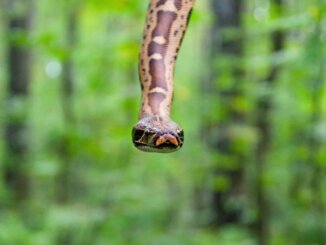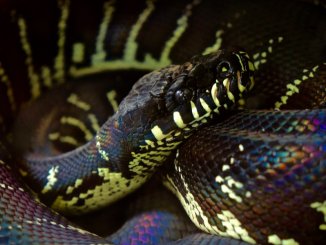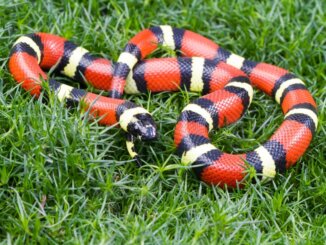The African house snake is a medium-sized, nonvenomous snake that is brown with faint stripes or spots along the body. The snake is native to sub-Saharan Africa, usually near villages or towns.
African house snakes are great starter pets for beginner reptile enthusiasts because the snakes are easy to care for and have only basic housing needs. Use this guide to create the right housing environment for these snakes to keep them healthy and happy.
African House Snake Overview
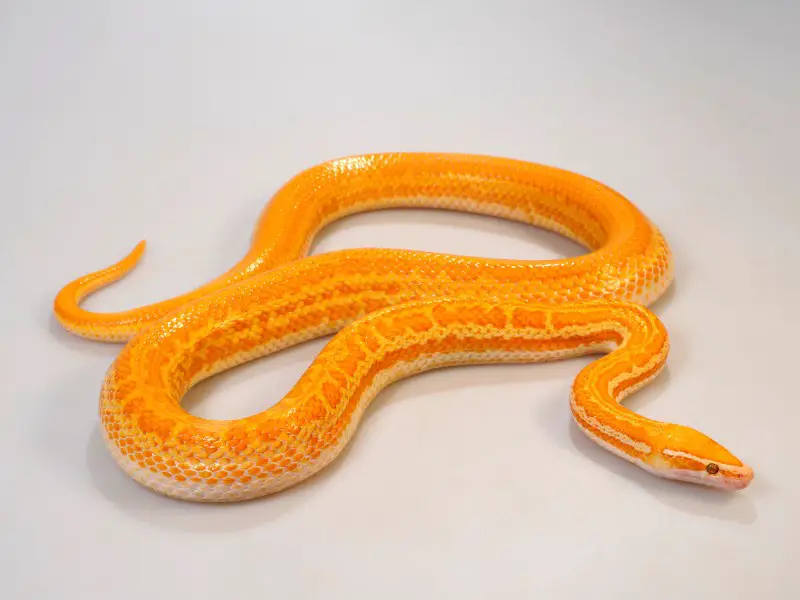
| Common name | African house snake |
|---|---|
| Scientific name | Boaedon fuliginosus |
| Natural habitat | Grassland, tropical forests, shrubland, and near villages or towns in sub-Saharan Africa. |
| Adult size | 2–5 feet |
| Average lifespan | 15–20 years |
| Diet | Frozen or live rodents, lizards, or small birds |
| Housing | Minimum enclosure size is 24 inches by 18 inches by 18 inches. Temperature gradient of 70–90°F and humidity level of 30%–50% |
| Experience level | Beginner |
Origin
The African house snake (Boaedon fuliginosus) is native to areas with warm climates in sub-Saharan Africa. The snake is found in shrubland, grasslands, wetlands, savannahs, tropical forests, and more recently near villages and towns in various countries across Africa.
The snakes inhabit areas near humans to feast on the rodents that are attracted to human waste. African house snakes are highly adaptable to different temperature and humidity ranges because they inhabit any areas where there is abundant prey. The African house snake is abundant in the wild and is not a threatened species.
Appearance and Behavior
The African house snake is a slender, medium-sized snake that is found in various shades of brown — from light brown to a darker chocolate color. The snake may have faint stripes or spots on its body.
Male African house snakes have longer and wider tails than females. Adult females are larger than adult males and can even be double a male’s size. Also, the tail of the female tapers more abruptly.
Size and Lifespan
African house snakes are between 2 and 5 feet long at full maturity. Males are rarely longer than 2 to 3 feet, and females grow up to 4 feet or longer.
The snakes will survive for 15 to 20 years in captivity if the enclosure is kept in the right temperature and humidity ranges and the snake is well-cared-for and fed a healthy diet. Buying a snake from a reputable breeder will also ensure a healthier snake with a longer lifespan.
Temperament
African house snakes are non-venomous and generally have a calm temperament. Juvenile snakes or snakes new to your enclosure may bite because of the unfamiliar territory, but will likely stop biting once they have settled.
This species can be housed with other snakes of the same species, but this is not recommended. These snakes have an aggressive feeding response and in some instances may eat or harm each other during feeding times. Male and female snakes should be housed separately because when housed together the snakes will breed all year round, without getting enough rest.
African house snakes can be handled, although juveniles may be nervous and jumpy. The snakes might bite when picked up from behind the head.
Housing African House Snakes
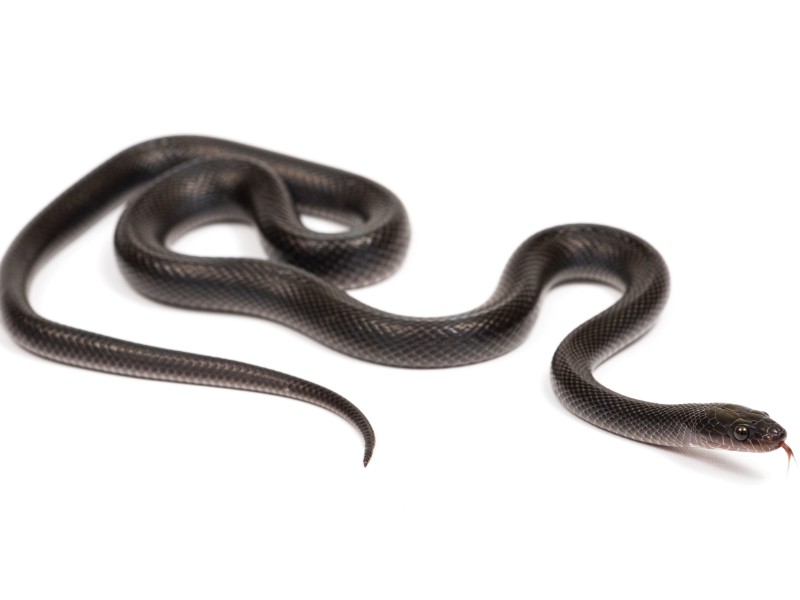
African house snakes are versatile in the wild and are found in a range of habitats including dense forests, grasslands, and deserts. The snakes are also commonly found in bushes close to houses. These snakes do well in various enclosures as long as the temperature is kept warm, but natural enclosures are recommended to mimic the snakes’ natural environment.
House these snakes in a vivarium or terrarium that is made of wood, plexiglass, or glass with plenty of ventilation, no small holes, and a sturdy escape-proof lid.
Enclosure Size
Adult African house snakes need an enclosure that is at least 24 inches by 18 inches by 18 inches but will be happy in a larger enclosure if possible. Add extra height in the enclosure for branches because these snakes like to climb often.
House juvenile house snakes and hatchlings in a 10-gallon tank or a larger enclosure. Increase the size of the enclosure when multiple snakes are housed together, such as during breeding or if two females are housed together.
Lighting
African house snakes are nocturnal but sometimes move around in the day and need a natural day-to-night lighting cycle to keep their internal clock on track. These snakes don’t need UVB to use the calcium in their diets. However, UVB should still be added to the enclosure to mimic the snakes’ natural environment.
Mount a UV tube on the ceiling at the back of the enclosure with a light gradient to provide the snake with hiding spots when it wants less or no light. Keep the lighting on a cycle that matches the day-to-night cycle in the area.
Temperature and Humidity
An African house snake needs warm temperatures to survive and remain healthy but is adaptable to slight temperature variances. Create a temperature gradient in the enclosure to allow the snake to move between the heat levels to regulate temperature.
Keep the temperature at a stable 70°F on the cool side of the enclosure while increasing it to 85 to 90°F on the warm side (also known as the basking side). Create the temperature gradient by placing a ceramic basking lamp on the hotter side of the enclosure, and monitoring the temperature with one thermometer on either side.
Add a heating pad underneath the substrate to heat the basking side if needed, keeping the temperature at 80°F, monitored with a thermostat placed on top of the bedding or by using an automatic heating mat that turns off when the temperature becomes too hot.
Turn the basking bulb off for 12 hours at night to create a drop in heat to mimic the nighttime temperatures in the wild. Place the bulbs outside of the enclosure to prevent the snake from reaching the bulb and hurting itself.
The humidity in the enclosure should stay between 30% and 50% to help the African house snake keep its skin moist, especially while shedding. Keep the humidity stable by misting the cage, keeping a bowl of water inside, and adding in a moist hide layered with sphagnum moss for the snake to use while shedding.
Place a hygrometer inside the enclosure to measure and keep the humidity stable at all times — low and inconsistent humidity levels will cause health issues for the snake. A well-ventilated enclosure is important to prevent the humidity from causing bacteria and fungal growth.
Substrate and Decoration
Add a high-quality substrate to the enclosure to keep the African house snake happy and to make the enclosure easy to clean. Add a thick (several inches) layer of aspen or beechwood chips to allow the snake to burrow.
Other substrate options include paper towels, newspaper, soil and clay mix, or reptile bark. Avoid any substrate that is difficult to clean because the snakes have fast metabolisms, which cause frequent defecation.
The African house snake doesn’t need an elaborately decorated enclosure, and a few key decorations will keep the snake happy. Add basking and climbing spots using large, flat rocks and tree branches on both the hot and cold sides of the enclosure. Monitor the heat of the basking rocks to prevent the snake from burning its belly if the temperature is too hot.
The snake needs plenty of places to hide, including shaded areas to move away from the light during the day. Place hides, caves, and large ornaments for shaded areas as well as plants for partial shade inside the enclosure.
Cleaning
Keep the enclosure clean to prevent disease and illness and allow the African house snake to thrive. Spot clean as often as possible — preferably every day — by removing fecal matter, leftover food, and skin from the snake’s shed.
Clean the enclosure fully approximately every four weeks by gently removing the snake from the enclosure and placing it in a ventilated tank or container. Remove all the substrate, decorations, and hides from the enclosure before spraying it with a reptile-safe disinfectant or a water and vinegar mix.
Rinse the enclosure and wipe it down before cleaning the decorations in the same manner, and place them back in the enclosure when everything is completely dry.
Clean the enclosure during the day to give the snake enough time to heat up in the basking temperature before the cooler nighttime temperatures set in.
African House Snake Care
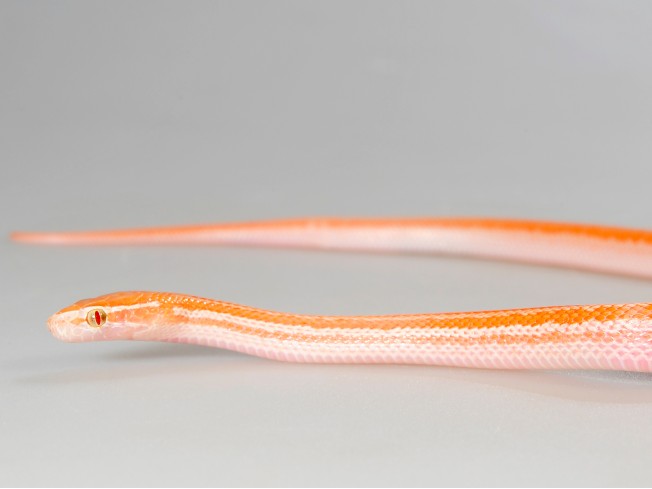
African house snakes are easy to care for, making them suitable pets for beginner reptile enthusiasts. The snakes have specific food, water, and handling requirements like any other reptile, but these requirements are easy for beginners to meet.
Food and Water
Feed an African house snake a diet of living or defrosted mice or rats that are no larger than the thickest part of the snake. An adult snake should be fed once a week or once every second week depending on the snake’s particular needs.
Since the snakes are opportunistic feeders, other prey options for snakes who reject rodents include small birds, geckos, bats, lizards, and frogs.
Feed young African house snakes a diet of living or defrosted pinkie mice once or twice a week, although thawed prey reduces the chance of the prey biting or harming the snakes.
These snakes are aggressive feeders and might bite your hand when placing the prey in the enclosure or during handling if your hand smells like the prey.
Keep a large water bowl on the cool side of the enclosure at all times for the snake to drink from and bathe in when cooling down. This snake will use the water to help during its shed.
Handling
An adult African house snake is easy to handle and doesn’t seem to mind being held. Always wash your hands before handling to prevent the snake from mistaking your hand for prey, because the snake — while mostly docile — can bite at times.
Hatchling and young African house snakes are more difficult to handle because they have more energy, are jumpy, and tend to bite more than adult snakes. Handle young snakes with care to get them used to being held, and they will likely become calmer as they grow.
Don’t pick up the snake behind the back of its head. Be careful when opening the top of the enclosure as these snakes — especially the young — like to spring up often.
Common Health Issues
As with any other reptile, African house snakes can develop certain health conditions that will reduce their lifespan or cause pain and discomfort. New reptile owners should take note of the following common conditions and seek veterinary care if any of the following conditions are suspected.
- Overfeeding — is a condition where the carer offers too much food to the snake. As avid feeders, these snakes will eat more than they need if the food is available. Consult a veterinarian to determine how much the snake needs if you suspect the snake is eating too much
- Mouth rot — is a condition caused by dirty housing, stress, or injury from live prey. Symptoms of mouth rot include mouth swelling or redness and excess mucus. Seek veterinarian care if mouth rot is suspected
- Mites and parasites — are common issues for these snakes and are passed on by prey or dirty housing conditions. Regular veterinarian check-ups will reduce the likelihood of parasites and mites affecting the snake
Breeding
African house snakes breed readily in captivity once a male and female are together in the enclosure. Only begin breeding the snakes when the male is two years or older and the female is three years or older. To ensure a healthy breed, keep the following in mind:
- Separate the two snakes during the colder months to prevent overbreeding and to give the snakes enough time to rest
- When the female lays three or four clutches per year, the snake will only be fertile for about four years
- During breeding, the male will eat less. This isn’t a concern, but keep feeding the snake and remove the prey after a day if the snake doesn’t feed
- The female will have a pre-lay shed about one month after mating and will eat less during this time. The shed indicates that the female will lay eggs in the next one or two weeks
- Place a nesting box filled with sphagnum moss in the enclosure to give the female a place to lay the eggs. If no nesting box is present, the snake will use the water bowl and the eggs won’t survive
- The female will lay between 8 and 20 eggs during a clutch. When the eggs are laid, incubate them at 75 to 84°F in a moisture-rich substrate
- The first eggs will hatch after 60 days, and the hatchlings will encourage the rest to hatch
- Hatchlings have aggressive feeding habits. Separate hatchlings and house them in small containers — especially during feeding time — to prevent the snakes from eating each other
- Feed the hatchlings defrosted pinkie mice after the first shed, which happens within a week of hatching
Choosing and Buying an African House Snake
African house snakes cost between $40 and $100. Buy these snakes from reputable breeders to ensure a healthy pet. Wild-caught snakes might carry disease and illness and are more nervous in captivity.
The snakes are abundant in the wild and in the pet trade because the snakes are fertile breeders. Look out for signs of illness when purchasing a snake, such as a red or swollen mouth, flaky or red skin, and unclear eyes.

